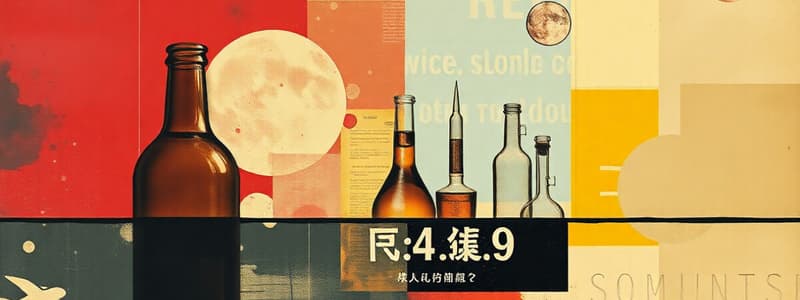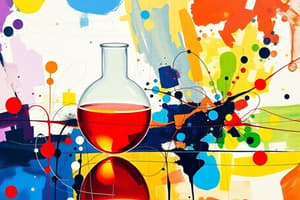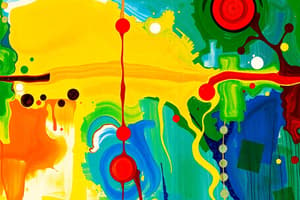Podcast
Questions and Answers
In a closed system at dynamic equilibrium, what condition must be met regarding the rates of the forward and backward reactions?
In a closed system at dynamic equilibrium, what condition must be met regarding the rates of the forward and backward reactions?
- The rates of the forward and backward reactions must be constantly fluctuating.
- The rate of the forward reaction must be greater than the rate of the backward reaction.
- The rate of the backward reaction must be greater than the rate of the forward reaction.
- The rates of the forward and backward reactions must be equal. (correct)
Consider the reversible reaction: $A(g) + B(g) \rightleftharpoons 2C(g)$. According to Le Chatelier's Principle, if the pressure on the system is increased, what will happen to the equilibrium?
Consider the reversible reaction: $A(g) + B(g) \rightleftharpoons 2C(g)$. According to Le Chatelier's Principle, if the pressure on the system is increased, what will happen to the equilibrium?
- The equilibrium will shift to the left, favoring the formation of A and B.
- The equilibrium will not be affected by the change in pressure.
- The rates of the forward and backward reactions will increase equally.
- The equilibrium will shift to the right, favoring the formation of C. (correct)
For an endothermic reaction at equilibrium, what effect does an increase in temperature have on the equilibrium position?
For an endothermic reaction at equilibrium, what effect does an increase in temperature have on the equilibrium position?
- It shifts to the left, favoring the formation of reactants.
- It shifts to the right, favoring the formation of products. (correct)
- It equally increases the rates of both forward and reverse reactions.
- It causes no change in the equilibrium position.
Consider the equilibrium: $N_2(g) + 3H_2(g) \rightleftharpoons 2NH_3(g) + heat$. Which action would shift the equilibrium to the left?
Consider the equilibrium: $N_2(g) + 3H_2(g) \rightleftharpoons 2NH_3(g) + heat$. Which action would shift the equilibrium to the left?
In a reversible reaction, the forward reaction is exothermic. If the temperature of the system at equilibrium is decreased, what happens to the equilibrium constant K?
In a reversible reaction, the forward reaction is exothermic. If the temperature of the system at equilibrium is decreased, what happens to the equilibrium constant K?
Flashcards
Reversible Reaction
Reversible Reaction
A reaction that can proceed in both the forward and backward directions.
Dynamic Equilibrium
Dynamic Equilibrium
The state where the forward and backward reactions occur at the same rate, resulting in constant reactant and product concentrations.
Le Chatelier’s Principle
Le Chatelier’s Principle
When a system at equilibrium is disturbed, it will shift to counteract the disturbance and restore equilibrium.
Equilibrium Shift Direction
Equilibrium Shift Direction
Signup and view all the flashcards
Pressure Effect on Equilibrium
Pressure Effect on Equilibrium
Signup and view all the flashcards
Study Notes
- Equilibrium involves reactions proceeding in both forward and backward directions.
Reversible Reactions
- Reactions can proceed in both forward and backward directions.
- In the forward reaction, nitrogen and hydrogen react to form ammonia.
- In the backward reaction, ammonia decomposes into nitrogen and hydrogen.
- Dynamic equilibrium occurs when both reactions happen at the same rate in a closed system.
Dynamic Equilibrium
- Forward and backward reactions occur at equal rates, maintaining constant concentrations.
- Equilibrium signifies a stable ratio between reactants and products, not necessarily equal amounts.
Le Chatelier’s Principle
- If a system at equilibrium is disturbed, it shifts to counteract the change.
Factors Affecting Equilibrium
- Increased temperature in an exothermic forward reaction shifts the equilibrium left, forming more reactants.
- Increased temperature in an endothermic forward reaction shifts the equilibrium right, yielding more products.
- Increased pressure in a system with gases shifts the equilibrium towards the side with fewer gas molecules.
- Increased reactant concentration shifts the equilibrium right, producing more products.
- Increased product concentration shifts the equilibrium left, forming more reactants.
Claim-Evidence-Reasoning Model Example
- The reaction in question is N₂ + 3H₂ ⇌ 2NH₃ + Heat.
- Claim: Increasing temperature shifts the equilibrium left, producing more reactants.
- Evidence: The forward reaction is exothermic, releasing heat; increasing temperature adds energy to the system.
- Reasoning: Le Chatelier’s Principle dictates the system opposes the temperature increase by favoring the endothermic (backward) reaction, absorbing heat and producing more N₂ and H₂, and less NH₃.
Studying That Suits You
Use AI to generate personalized quizzes and flashcards to suit your learning preferences.




